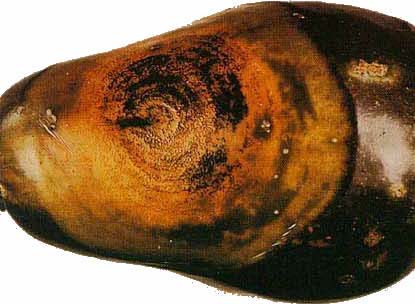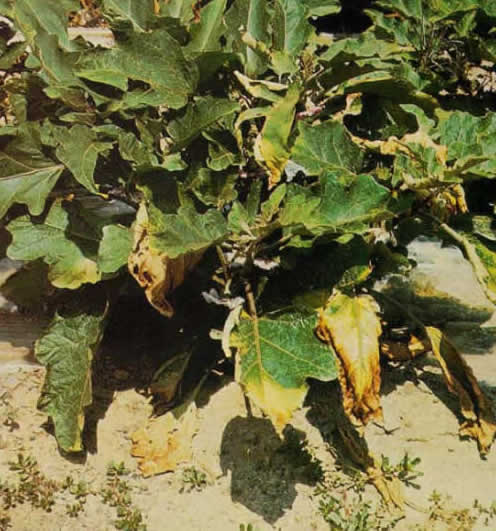Diseases
Damping off (Pythium spp., Phytophthora spp., Rhizoctonia spp.)
A serious disease in the nursery. High soil moisture and moderate temperature along with high humidity especially in the rainy season favour the disease. Two types of symptoms are observed, viz., pre emergent and post emergent damping off. The pre emergent damping off results in rotting of seed and seedling before emerging out of soil. Whereas in the post emergent damping off, seedlings after emergence are infected near the collar region at ground level. The infected tissues become soft and water soaked. The collar portion rots and ultimately the seedlings collapse and die.
Control: For avoiding damping off in the nursery, sow the seeds as thin as possible in the raised beds prepared in the open area during summer months. Soil solarisation of nursery buds for 30 days prior to sowing and seed treatment with Trichoderma @ 5 g/kg is effective in managing the disease. Healthy seeds should be selected for sowing and should be treated with Thiram @ 2g/kg of seed before sowing. Continuous raising of nursery in the same plot should be avoided. The topsoil of nursery should be treated with Thiram @ 5g/sq m area of the soil and nursery should be drenched with the same chemical @ 2g/litre of water at fortnightly interval. Soil solarization by spreading 250 gauge polythene sheet over the bed for 30 days before sowing and application of bio-control agent Trichoderma viride in soil @ 1.2 kg/ha is also found effective to considerable extent.
Phomopsis blight (Phomopsis vexans)
It is a serious disease of brinjal infecting the foliage and the fruits. The fungus infects the seedlings in the nursery causing damping off symptoms. When the leaves are infected, small circular spots appear which later become grey to brown with irregular blackish margins. Symptoms on fruits appear as minute, sunken dull and dusky spots, which later merge and the infected fruits rot.

Control: Adopting good field sanitation, destruction of infected plant material and crop rotation help to reduce the spread of the disease. Seeds obtained from disease free plants should be used for planting. Seed treatment with Thiram (2 g/kg seed) protects the seedling in the nursery stage. Spraying with Dithane Z-78 (0.2%) or Bordeaux mixture (1%) effectively controls the disease in the field.
Fruit rot (Phytophthora nicotianae)
The symptoms first appear as small water soaked lesions on the fruit, which later enlarges in size considerably. Skin of infected fruit turns brown and develops white cottony growth. High humidity favours the development of the disease.
Control: Removal and destruction of the affected fruits and spraying the crop with Dithane M-45 (0.3%) thrice at an interval of 10 days effectively controls the disease.
Verticillium wilt (Verticilium dahliae)
All stages of the crop are susceptible to the disease. The infected young plants show dwarfing and stunting due to the shortening of the internodes. Such plants do not flower and fruit. Infection after the flowering stage results in development of distorted floral buds and fruits. The affected fruits finally drop off. Infected leaves show the presence of irregularly scattered necrotic pale yellow spots over the leaf lamina. Later on, these spots coalesce resulting in complete wilting of the leaves.

Control: Crop rotation with bhindi, tomato, potato should be avoided. Soil application and foliar application with bavisin (0.1%) is effective in reducing the wilt disease.
Bacterial wilt (Psedomonas solancearum)
Bacterial wilt disease is a serious problem for brinjal cultivation in Kerala. The characteristic symptoms of the disease include wilting of the foliage followed by collapse of the entire plant. The wilting is characterized by gradual yellowing, withering and drying of the entire plant or some of its branches.
Control: Removal and destruction of affected plants and using disease resistant varieties like Surya, Swetha and Haritha and the hybrid Neelima in bacterial wilt prone areas help to reduce the disease incidence. Crop rotation with bhindi, tomato, potato should be avoided. Before sowing the seeds should be dipped in a solution of streptocycline (1 g/ 40 litres of water) for 30 minutes.
Little leaf of brinjal
A viral disease of brinjal transmitted by leafhoppers. Leaves of the infected plants are small and malformed with light yellow colouration. Infected plants show stunted growth with shorter internodes and petioles, and large number of branches and roots than normal giving the plant a bushy appearance. Flower parts are deformed and sterile and do not normally bear fruits, and if fruits are formed they will be hard and tough and will fail to mature.
Control: Adopting sanitary measures like early removal and destruction of infected plants and eradication of susceptible volunteer crop plants of the previous season can reduce the damage. Use of barriers of trap crops and adjusting sowing time to avoid the main flights of leafhopper vector is also recommended. Spraying malathion (2 ml/litre of water) starting with the appearance of the leafhoppers controls their population.
Mosaic
A viral disease caused by Potato Virus Y and transmitted by aphids like Aphis gossypi and Myzus persicae. Characteristic symptoms of the disease are mosaic mottling of the leaves and stunted growth of the plant when infected in the early stages. The leaves of infected plants are deformed, small and leathery.
Control: The disease incidence can be minimised by reducing the population of aphids, removal and destruction of infected plants and eradication of susceptible weed hosts.
